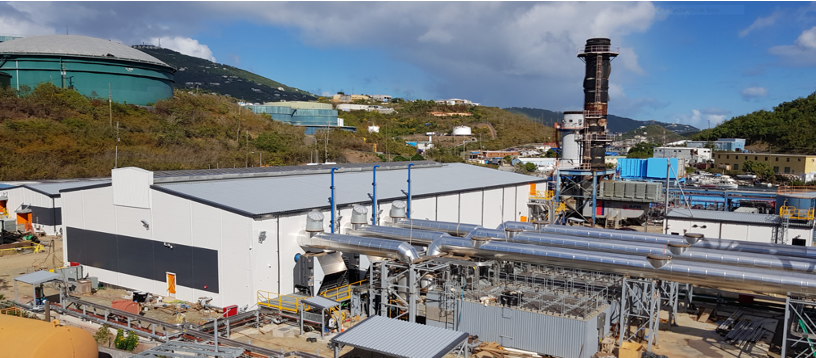It’s no secret that a growing number of markets worldwide are pushing towards increasingly ambitious decarbonisation targets. But the reality for most grids on the planet is that renewables and fossil-fuel-powered plants will have to coexist for some time to come. This is true not only of major electricity networks but also of microgrids, island grids and off-grid hybrid generation setups, where intermittent renewable sources such as wind and solar must be paired with energy storage and fossil-fuel engines such as diesel gensets to achieve a fully reliable supply.
Optimising such systems is no mean feat. As well as trying to match supply to variable demand, the hybrid system operator must coordinate engine capacity and energy storage charge-discharge cycles to fill in for intermittent renewable production on a second-by-second basis, while ensuring there is always a reserve margin available.
The Wärtsilä Engine+ Solution
This level of control clearly calls for an automated system, but few vendors have the breadth of industry experience to deliver a package that can optimise all the elements within such complex hybrid setups. Thus, an energy storage vendor may provide software that optimises battery operations but cannot do the same for engines. The same goes for solar inverter software or wind supervisory control and data acquisition systems.
Wärtsilä, on the other hand, is an experienced provider of a wide spectrum of energy technologies and has brought this experience to bear on a platform built specifically for the control of hybrid renewable plants incorporating legacy engines and next-generation energy storage. The Wärtsilä Engine+ GEMS solution is a comprehensive package that integrates Wärtsilä hybrid power plants seamlessly with renewable generation, ensuring stable and uninterrupted power supplies while delivering economic and environmental benefits.
Operational Excellence
The Wärtsilä Engine+ GEMS solution enables asset owners and operators to enjoy four key benefits from the operation of hybrid plants:
- The lowest possible levelised cost of energy, reducing fuel consumption and maximising renewable generation.
- Improved power quality achieved by adding fast-responding battery assets to the power generation mix.
- Enhanced grid reliability as a result of optimising asset dispatching and maintaining reserve levels.
- Predictable energy generation using load and renewable energy generation forecasting.
Six Key Features
Wärtsilä’s Engine+ GEMS solution covers all the functions required for reliable grid operations, including:
- Primary response, provided via engine governors and Wärtsilä energy storage systems. Electronic control allows batteries to regulate frequency and voltage when facing large load steps or renewable power ramps.
- Secondary control, maintaining high grid quality by distributing real and reactive powers across all running engines and energy storage units.
- Tertiary control, dispatching engines, batteries and renewable generation at any given time to achieve the best economic optimisation.
- Renewable energy forecasting, using weather forecasts, statistical models, non-parametric machine learning and more.
- Load forecasting using machine learning, which enables predictions to get progressively more accurate over time.
- Emergency handling to ensure grid reliability in response to failures, generation interruptions or load changes.
CASE STUDY: THE US VIRGIN ISLANDS WIND AND POWER AUTHORITY

Photo: Wärtsilä
Like many island-based energy suppliers, the US Virgin Islands Wind and Power Authority (WAPA) is keen to embrace cleaner, cheaper sources of electricity generation but cannot afford to compromise its security of supply. To this end, it has looked to expand its generation assets with a combination of energy storage and highly efficient liquid petroleum gas (LPG) and light fuel oil (LFO) engines.
Leading technology
In 2020, WAPA turned to Wärtsilä for four 32LG engines, capable of burning LPG and LFO, with a total output of 36 MW, plus an energy storage system offering a further 9 MW for up to two hours. Control of the hybrid setup, which complements an earlier 21 MW Wärtsilä power plant running primarily on propane gas, is via Wärtsilä’s Engine+ solution.
Adding flexibility
When it goes live in 2022, the Randolph Harley Power Plant will provide much-needed additional baseload capacity to the island’s electricity supply. It will also improve the system’s reliability, while at the same time giving the grid additional fuel and operational flexibility that will increase efficiency and lower overall operating costs.
Cutting diesel
Last but not least, it will reduce WAPA’s dependence on diesel fuel and hence reduce the environmental impact of electricity generation. The four new generators are fuelled by a cleaner-burning fuel which will lead to reduced emissions and enhanced overall air quality, with no adverse impact to land, water or the surrounding area.
Lower costs
Perhaps more significantly for WAPA’s customers, the new units will allow WAPA to end a costly generator lease and commence the decommissioning of older, less reliable assets which only operate on more expensive oil sources. With the units operating fully on LPG fuel, WAPA anticipates that electricity rates can be lowered by four cents per kilowatt hour, a welcome saving.

